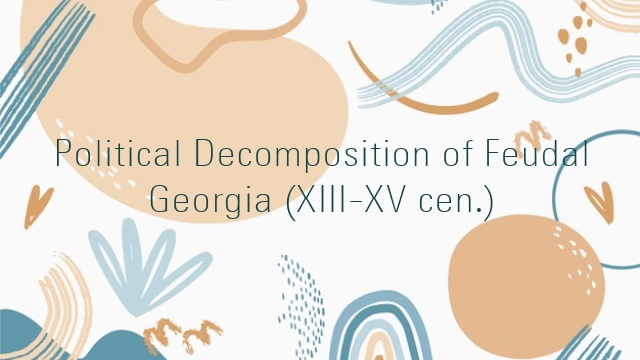
During the period of reign of Rusudan there appeared the internal crisis in the feudal society, which shook the strength of the country and became the reason of defeat of Georgians by the enemies. In 1225-1231 Shah of Korasm, Jalal Eddine, several times successfully invaded Georgia. He also took Tbilisi and exterminated the large part of its christian population. True, soon after that he was defeated in the struggle with Mongolians and died, but the weakened from his invasions Georgia stayed against the stronger enemy – Mongolians. In 1243 Rusudan had to officially accept the supremacy of Mongolian Khan. Mongolians didn’t abolish Georgian Kingdom, which was the result of resistance of Georgians. Conquerrors stopped at the step that the king recognized the supreme government of Genghisides, that he would pay annual tribute and in the case of necessity help them with the military forces.
After the death of Rusudan there appeared two pretenders for the state throne: the son of Lasha-Giorgi, David-Ulu, and the son of Rusudan, David-Narin. In 1247 Mongolians affirmed the both of them as the kings, which obviously created the fore-condition for the country decomposition.
The domination of Mongolians heavily laid on Georgia. The annual tribute destroyed the economical basis of the coutry. Besides, Georgians regularely had to participate in the far struggles of Mongolians, which was connected to the material outlays and human victimization.
To get rid of this situation, in 1259 the king, David-Narin rebelled against Mongolians and moved to West Georgia, which was declared as the independent kingdom. It was the beginning of political decomposition of the country, because East Georgia, with the subordinated northern Armenia stayed in the hands of David-Ulu and his inheritors, as the Autonomous kingdom, entering the Mongolian Empire.
The kings of East Georgia were trying to avoid this subordination. The rebellions, arranged by them in 1260-1261, 1297-1311 are famous, which were followed by the wide military activities. The final liberation of Georgia from the Mongolian domination happened in the period of the king Giorgi V the Splendid (1314-1346). Giorgi V annexed to Georgia also West Georgian kingdom and thus restored the political integrity of the country.
Liberated Georgia stood on the way to revival, but in 80s of the XIV cen. there appeared the new enemy – Tamerlane. This terrible Middle-Asian conquerror invaded Georgia in 1386-1403 eight times and ruined it, exterminated or captured the important part of the population. This was one of the largest distruction, that had happened in the history of Georgia. Inspite of that, Tamerlane still couldn’t manage to make the whole Georgia obey.
The invasions of Tamerlane caused the horrible damage for the Feudal Georgia. Catastrophically fell economic, the population was abbreviated, the coutry stood on the way to the cultural flinch. Georgians were involved in the permanent wars, which were hold by the kingdoms arisen on the ruins of the Empire of Tamerlane. The invasions of nomadic tribes were endless.
In the second half of the XV cen. the foreign political condition of Georgia was aggraviated. Defeat of Konstantinopole by Ottoman-Turks in 1453 destroyed the contact with the Christian Europe for the country. Georgia was alone surrounded by the Muslim kingdoms and became the object of their permanent aggression.
The endless wars, economical and cultural flinch became the reason of the delay of the internal development of Georgia. The long period of stagnation began, the one of the results of which was the political decomposition of the country. At the end of the XV cen. Georgia was divided into Kartli, Kakheti and Imereti kingdoms, and Samtskhe Princedom. But neither these small kingdoms were the centralized units and from their side consisted of several subordinated dominations, the strongest of whom, Megrelia, Abkhazia and Guria Princedoms soon separated from Imereti kingdom and reached the independence from it.
In the princedoms there also were creating semi-independent seniors – satavados, which mean dominion of the prince (the title “tavadi” was separated from the dominating class in the XV cen.). Tavads, big, landowners, were the vassals (subordinated) of the kings and princes, but had administrative, judicial and tax immunities in their dominions. They had own military forces. The word “nobleman” meant only a small feudal afterwards. Aznaurs were the vassals of the kings, princes, tavads and the church. The obligation of the feudal-vassals was military service at first. At the time of the political disintegration of Georgia the serfdom was already firmly established in the country. The big part of peasants and city merchants and handicraftsmen were just the serves of the kings, feudals and the church. The wide layer of the private free peasants is remained only in the highlands of Georgia and in Abkhazia.
At the time of political decomposition of Georgia, there already were a long ago established serf relations. The large part of peasants and city merchant-handicraftsmen was the slave layer of the Kings, feudals and churches. The wide layer of independent peasants was only in higland regions and in Abkhazia.
by Dr. George Anchabadze





